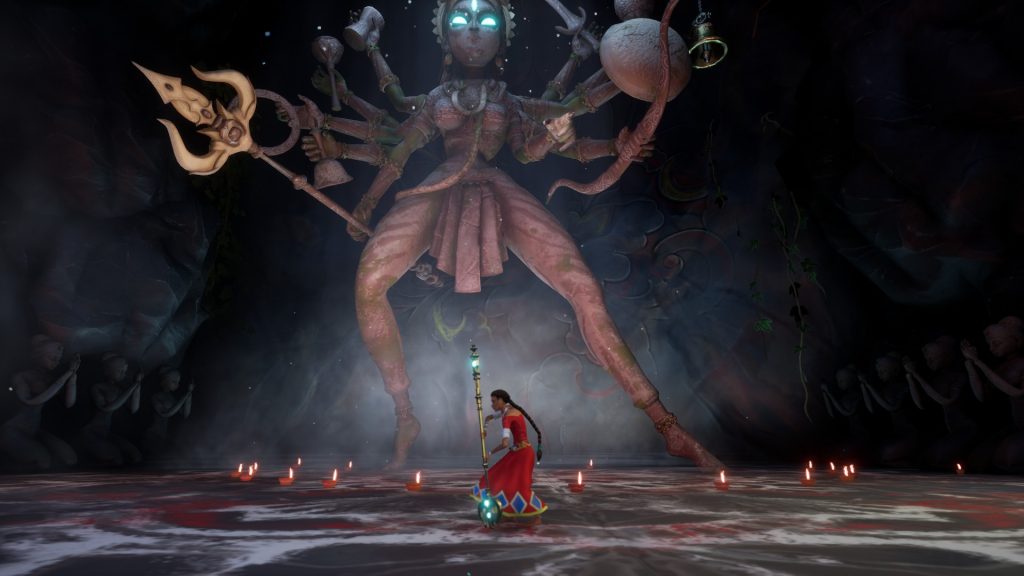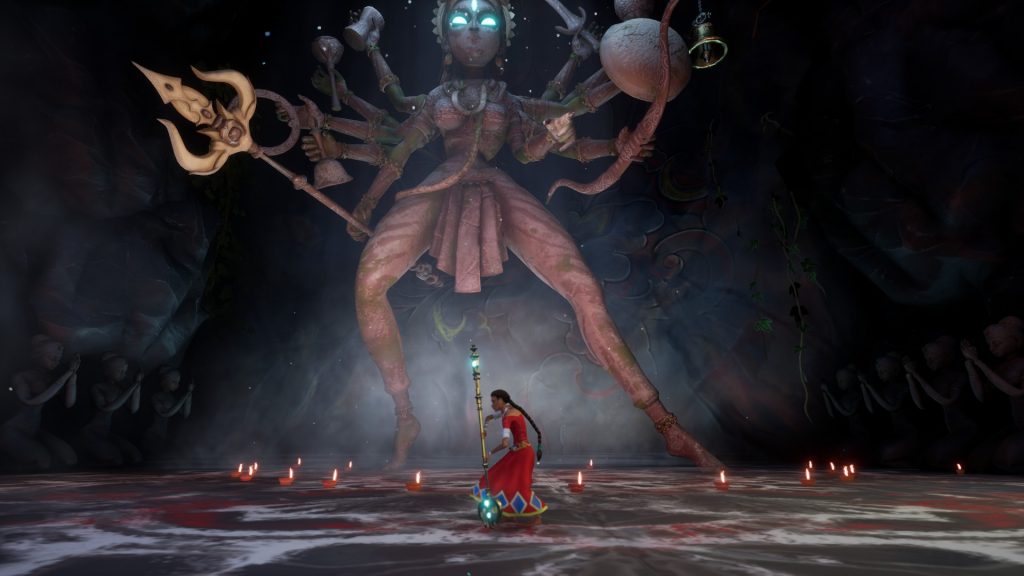
There are lots of games that use elements of Hindu mythology. Shin Megami Tensei and its many spin-off franchises, Smite, Dungeons & Dragons, and countless other fantasy settings all draw from Indian mythology here and there to create their creatures, enemies, and playable characters.
However, despite how many games there are that pull from Indian myths and legends, there aren’t too many games explicitly about the Hindu gods and heroes. Asura’s Wrath and Asura are two of the few video games about Indian mythology that immediately come to mind, even if they are only loosely based on the subject matter.
I’m certainly no expert on Hindu and Indian myths, but I’ve always found the things I do know fairly interesting. That’s a big part of why I was looking forward to Raji: An Ancient Epic. This Indian-developed action-platformer celebrates the stories and legends from this underutilized culture. While it’s certainly not a fantastic game, it was clearly made with a lot of heart and care.
Raji: An Ancient Epic
Developer: Nodding Head Games
Publisher: Super.com
Platforms: Windows PC (Reviewed), Nintendo Switch, PlayStation 4, Xbox One
Release Date: October 15th, 2020
Players: 1
Price: $24.99
Raji: An Ancient Epic is the story of Raji and her little brother Golu, two young performers for a traveling carnival. Raji is an acrobat, while her little brother puts on shows about ancient legends and the Hindu gods using shadow puppets.
The two are performing at a large festival when it is attacked by Mahabalasura, a deranged mystic leading an army of demons. Golu is taken in the chaos of the attack, and Raji sets out on an adventure to rescue her brother.
Luckily, Raji is not alone in her quest. Her devotion and piety has earned her the favor of Durga, Vishnu, and Shiva. While the gods can’t intervene in her journey directly, they are able to guide her behind the scenes.
Raji is at its best when the game allows you to just explore and immerse yourself in its lovingly crafted world. While the levels are very linear, they are beautiful to behold, with lots of sprawling shots of gorgeous backdrops, and interesting locales that range from scorching deserts, to bizarre retro-futuristic temples.
The world and story are fleshed out with some really solid narration by Durga and Vishnu as they watch over Raji on her quest. You’ll also find plenty of paintings and murals depicting Indian stories. Interacting with these murals will result in Vishnu giving a quick overview of the legend, and its messages.
The game also has some excellent music recorded with traditional India instruments, and cutscenes that use a shadow puppet-like art style. All of these elements combine to make a game with excellent presentation and storytelling.
Much of the game involves light platforming and puzzle elements as you navigate its breathtaking levels. The platforming isn’t especially difficult or complex, and serve mostly as a vehicle to show off the game’s environments.
The platforming can be a little janky at times however, due to the game’s strange camera angles. The game will occasionally shift to a pseudo-2.5D side view during platforming, but still operates as a 3D game.
This means that you can fall to your death by jumping into the foreground or background. Likewise, there are some parts where you jump on platforms in said foreground or background. The camera angle in these segments can make it difficult to judge distances, and can result in some annoying deaths.
The puzzles are also quite simple, and typically involve rotating images to form a complete picture. Some of these are circular pictures depicting events from Raji and Golu’s childhood, while others are cursed trees with demonic faces that need to be purified to dispel the corrupting power of Mahabalasura.
One of the more involved puzzles is in the game’s water level, where you have to throw lilies into the water to create paths. You can only have two lilies out at once, and can only hold a single flower seed, leading to some segments where you have to optimize the pathway to reach secrets and other optional content.
Raji’s journey isn’t always so peaceful, and you’ll frequently have to stop to slay some of Mahabalasura’s demons. As a circus acrobat, Raji’s fighting style is quick and fluid, with the game’s combat focusing a lot on dodges, swinging around columns to strike multiple foes, and vaulting off of walls and objects to get behind enemies.
In terms of weaponry, Raji has access to three weapons that you’ll acquire over the course of the game. Each of them is a gift from one of the gods watching over her, and include a spear, a bow, and a sword and shield. They all act as you’d expect, with the spear having longer reach, the bow allowing you to unleash volleys from afar, and the sword and shield allowing you to block incoming attacks.
They have some useful secondary abilities too, like being able to throw the spear like a javelin, or the bow being able to rain arrows over a wide area to strike groups of demons. There is a fourth weapon too, but it’s basically just a superweapon given to you for the final boss fight in the last moments of the game.
Each of your weapons can be enhanced with powers granted to you by Durga, Vishnu, and Shiva. These coat your weapons in electricity, fire, or ice, and include three proc effects that you can upgrade using magic orbs you’ll find throughout your quest.
While this is a cool idea, some of the proc effects are functionally the same, with the only real difference being the flavor of elemental rage you’re are bringing down upon your foes. For example, both Vishnu and Durga have a proc that rains projectiles onto the battlefield, and another bounces attacks between enemies. In Durga’s case, the proc is lightning strikes, while for Vishnu it’s fireballs or meteors.
Each god only has one ability that is truly “unique.” For Vishnu, it’s a proc that sets enemies on fire and deals damage over time. Durga and Shiva’s equivalent is functionally very similar though, as they both are basically just stuns.
Durga uses lightning to electrify a foe, while Shiva encases them in ice. Either way, the end result is that when the ability procs, some of your enemies will be left defenseless for a few seconds so you can get some free hits in.
Rounding out your arsenal is a range of ultimate attacks that use magic charges that you’ll acquire from shrines scattered throughout the world. You can have three at once, and they are given to you frequently enough that you can use them quite liberally. Regardless of the element or weapon equipped, the ultimate attack boils down to “deal lots of damage to everything in your immediate vicinity.”
Enemy variety is a little lacking as well. There are hulking ogre-like demons, smaller monkey-like demons that tend to come in swarms, flying gargoyle creatures that swoop down at high speeds, and toad-like humanoids that hop around on long arms and spew bolts of acid.
One of the more interesting designs are these mechanical floating eyes that shoot laser beams. This particular enemy has a neat variant that will trap you in a bubble field, and then use that bubble like a trackpad to quickly rotate around out of reach.
While the game does a good job making each enemy feel unique, Raji frequently falls into the lazy trap of trying to increase combat variety by just throwing larger, tougher versions of past enemies at you.
A similar problem exists with the boss encounters. While the bosses are visually interesting, they have a pretty limited number of attack patterns and quite a bit of health, which makes the battles feel unnecessarily long and drawn out.
The bottom line is that Raji‘s combat system isn’t especially complex or challenging. You can regain health by executing enemies that are sufficiently weakened. Doing so completely restores your own health, so you really won’t be in any danger of dying if you just dodge and hit the execution prompts whenever they appear.
The only real challenge are the aforementioned boss fights, which don’t feature any health pickups or checkpoints. Even then, its not that the bosses are especially difficult, its just that the battles are drawn out so long that you are bound to make mistakes eventually.
Raji’s moves are also a bit more sluggish than the flashy acrobatic animations would suggest at first glance, which adds a little artificial difficulty to the battles. There is a noticeable delay with some of the animations that you’ll need to get used to, and it’s very easy to get stun-locked by multiple enemies if you aren’t careful.
Even with its faults, I wouldn’t say that the combat is necessarily bad, it’s just a lot of style over substance. It’s functional, and can even be fun at times. At the same time, there isn’t a ton of depth to it, and the encounters aren’t particularly challenging most of the time.
Raji is also a pretty short game, coming in at around four to five hours. The ending is extremely abrupt, which makes the game feel a bit unfinished. There isn’t much reason to play through Raji again either, unless you want to find the handful of secrets you might have missed during your first time through.
While I have been quite harsh on Raji: An Ancient Epic, there is still a lot to like about the game. The visuals, soundtrack, and narration are all really good, and come together to create a truly immersive experience based on myths and legends that you don’t really see portrayed too often in video games. It was engaging to explore the world in Raji, and hear ancient stories that you might not have been exposed to before.
The combat isn’t too great in its current form, but I can see some good ideas here and there that, if expanded upon, could lead to a pretty solid battle system. It’s just a shame what we have here is so simple, and not as smooth to actually control as it might look in trailers and videos.
Nodding Head Games clearly have a lot of passion for the subject material, and you can see that they definitely put a lot of heart and soul into Raji. With more experience and a better budget, they could probably make a game that is every bit as fun to actually play as it is to immerse yourself in. The abrupt ending teases at a potential sequel, so hopefully they’ll have another chance to improve upon what they have created thus far.
Raji: An Ancient Epic was reviewed on Windows PC using a review copy provided by Super.com. You can find additional information about Niche Gamer’s review/ethics policy here.
